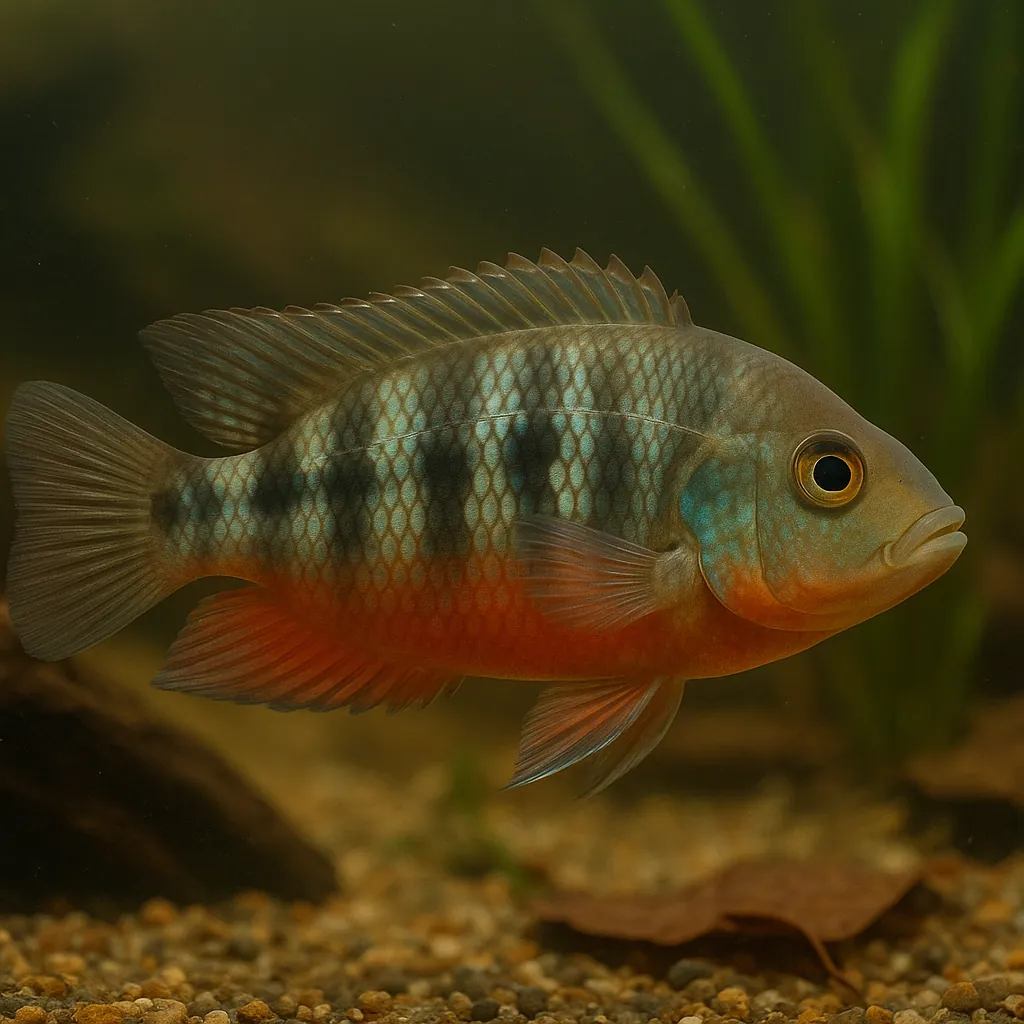
Chameleon cichlid
Introduction
The Chameleon cichlid (Australoheros facetus), also known as the chanchito, is a captivating freshwater fish cherished by aquarists for its dynamic coloration and engaging behavior. Native to South America, this species is renowned for its adaptability and resilience, making it a suitable choice for both novice and experienced fishkeepers. With proper care, Chameleon cichlids can thrive in home aquariums, offering enthusiasts a glimpse into their fascinating natural behaviors.
What makes the Chameleon cichlid a popular choice among aquarists?
Its vibrant color changes and hardy nature make it appealing to fishkeepers seeking an interactive and visually striking species.
Is the Chameleon cichlid suitable for beginners?
Yes, due to its adaptability and tolerance to various water conditions, it is considered suitable for beginners with some basic fishkeeping knowledge.
Care and Environment
Providing optimal care for the Chameleon cichlid involves attention to tank setup, water parameters, diet, and understanding their behavioral traits.
What is the minimum tank size for a Chameleon cichlid?
A minimum tank size of 100 liters is recommended for a pair, ensuring sufficient space for swimming and territory establishment.
What are the ideal water parameters for Chameleon cichlids?
They thrive in temperatures between 25-29°C, with a pH range of 6.5-7.5, and water hardness between 3-15 dGH.
To replicate their natural habitat, incorporate a soft substrate like sand or fine gravel, as Chameleon cichlids are avid diggers. Decorate the tank with bogwood, rocks, and caves to provide hiding spots and territorial boundaries. Live plants may be uprooted due to their burrowing behavior; therefore, opt for hardy plants like Java Fern or Anubias attached to hardscape elements.
Efficient filtration is crucial to maintain water quality, especially during breeding periods when they become more territorial. Regular water changes help keep the environment stable. Lighting should mimic natural daylight cycles, supporting both the fish's health and any live plants present.
Chameleon cichlids are omnivorous, feeding on a variety of foods. A balanced diet includes high-quality cichlid pellets, supplemented with live or frozen foods such as brine shrimp and bloodworms. Occasional vegetable matter, like blanched spinach or spirulina flakes, can be offered to ensure nutritional diversity.
How often should Chameleon cichlids be fed?
Feed them once or twice daily, providing only as much food as they can consume in a few minutes to prevent overfeeding and maintain water quality.
Be aware that Chameleon cichlids can exhibit increased aggression during breeding. Providing ample space and hiding spots can help mitigate territorial disputes.
Origin and Habitat
Chameleon cichlids are native to the Río de la Plata Basin, encompassing regions in Argentina, Brazil, Paraguay, and Uruguay. They inhabit a variety of freshwater environments, including rivers, creeks, swamps, and lakes. These habitats are characterized by moderate flow, abundant vegetation, and soft substrates, which the cichlids utilize for foraging and shelter.
What type of environments do Chameleon cichlids prefer in the wild?
They favor freshwater bodies with moderate flow, rich vegetation, and soft substrates, such as rivers and swamps.
Are Chameleon cichlids found outside their native range?
Yes, they have been introduced to regions like southern Iberia and Chile, where they have established populations.
Temperament and Compatibility
Chameleon cichlids are known for their territorial behavior, especially during breeding seasons. While they can coexist with other fish, careful selection of tank mates is essential to maintain harmony.
Are Chameleon cichlids aggressive?
They can be territorial and exhibit aggression, particularly during breeding periods.
What are suitable tank mates for Chameleon cichlids?
Compatible tank mates include similarly sized, robust fish such as other South American cichlids like Convict or Firemouth cichlids. Non-aggressive bottom dwellers like Bristlenose Plecos can also coexist peacefully.
It's advisable to avoid housing them with small, delicate, or overly aggressive species to prevent bullying or stress. Providing ample hiding spots and visual barriers can help reduce territorial disputes.
Interesting Facts
The Chameleon cichlid holds a notable place in aquarium history, being one of the first cichlid species widely kept by hobbyists. Its common name, "chameleon," derives from its ability to change coloration based on mood, environment, and breeding status.
Why is it called the Chameleon cichlid?
Due to its remarkable ability to change colors in response to various stimuli, much like a chameleon.
How do Chameleon cichlids reproduce?
They are open spawners, laying eggs on flat surfaces like stones or wood. Both parents actively guard the eggs and fry for up to three weeks, showcasing strong parental care.
These cichlids are also known for their adaptability, tolerating a range of water conditions and temperatures, which contributes to their resilience in both native and introduced habitats.
Sources
All information in this article has been gathered from the following reputable sources:
Overview
Recommended Tank Size 52.8 Gallons (for groups of 4 or more) |
Minimum Group Size 1 |
Minimum Tank Volume 26.4 Gallons |
Maximum Adult Length 7.7 inches |
Average Adult Length 7.1 inches |
Shoaling (6+ required) No |
Preferred Water Type Freshwater, slightly acidic to neutral |
Temperature Range (°C) 25-29 |
pH Range 6.5-7.5 |
Water Hardness (dGH) 3-15 |
Typical Lifespan (years) 8 years |